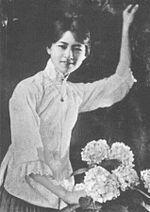Lin Huiyin
Lin Huiyin was born in Hangzhou, Zhejiang, China on June 10th, 1904 and is the Architect. At the age of 50, Lin Huiyin biography, profession, age, height, weight, eye color, hair color, build, measurements, education, career, dating/affair, family, news updates, and networth are available.
At 50 years old, Lin Huiyin physical status not available right now. We will update Lin Huiyin's height, weight, eye color, hair color, build, and measurements.
In the wake of the September 18th Incident, Lin left for Beijing, where she studied ancient Chinese architecture. Upon her return, she helped to establish the Architectural Department at Northeastern University in Shenyang, where she then taught architecture briefly. Meanwhile, in 1928, she designed a railway station in Jilin. This was one of the few buildings Lin designed. Throughout the 1930s, Lin and her husband lived in Beiping, as Beijing was then called, near both of their families. Close friends at the time were the Americans Wilma and John K. Fairbank, who admired her sense of living on a “kind of double cultural frontier,” and facing the problem of “the necessity to winnow the past and discriminate among things foreign, what to preserve and what to borrow.” He recalled the joy she took when she and her husband climbed the roof of the Temple of Heaven, which made her the first woman to attempt the walk on the emperor's palace roof and when in 1937, she discovered the main hall of Foguang Temple near Doucun, Shanxi. The hall was the only remaining Tang dynasty timber structure known at the time.
As Japan's invasion loomed, Lin Huiyin and her husband had to cut-short their promising restoration work of Beijing's cultural heritage sites in 1937 and abandoned their now famous courtyard residence in Beijing to flee southward along with personnel and materials of the Architectural Department of Northeastern University; their exodus lea them and their children to temporary settlements in the cities of Tianjin, Kunming, and finally Lizhuang in 1940. It was in Lizhuang where the bedridden Lin, still suffering from tuberculosis, was told of her younger brother's martyrdom while serving as a combat aviator in the air force in the defense of Sichuan. Lin wrote a poetic memorial:
After 1949, Lin Huiyin became a professor of architecture at Tsinghua University. As a literary writer and architectural historian, Lin Huiyin rebuilt the capital from the aspects of cultural tradition, architectural beauty, historical significance, and living conditions of the people. Meanwhile, Lin Huiyin participated in the design of the National emblem and the Monument to the People's Heroes. Lin designed the floral wreath patterns at the base of the Monument to the People's Heroes. Lin also took part in the standardization of Beijing city planning.
She died in 1955 of tuberculosis.

